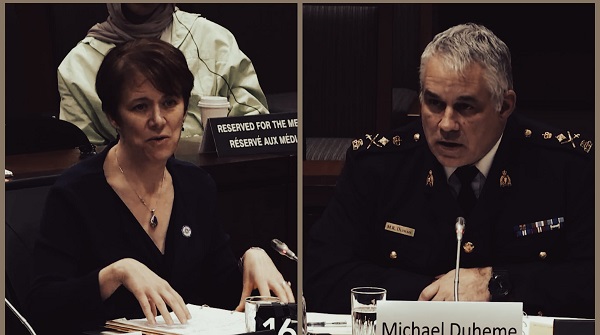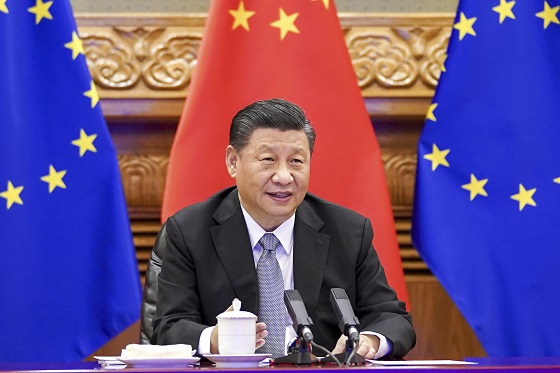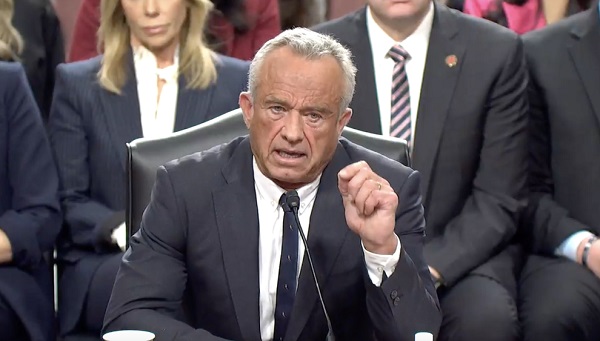National
Fentanyl, Firearms, and Failures: Canada’s Border in Crisis Mode

Opposition Exposes Legislative Gaps and Diplomatic Tensions as Trudeau Government Defends Record
In the latest session of the Standing Committee on Public Safety and National Security (SECU), the Trudeau government’s border security strategy faced fierce scrutiny.
MPs from the Conservative Party, Bloc Québécois, and NDP unleashed a barrage of criticism, exposing deep flaws in how Canada handles fentanyl trafficking, organized crime, and illegal migration. Witnesses from the Canada Border Services Agency (CBSA) and Royal Canadian Mounted Police (RCMP) offered opening statements aimed at highlighting their agencies’ efforts but quickly found themselves on the defensive, trying to justify their performance amid systemic failures.
CBSA and RCMP: Opening Statements Outline Growing Challenges
CBSA President Erin O’Gorman opened the SECU meeting with what can only be described as a pre-packaged, self-congratulatory performance. She boasted about “proactive” border security measures, highlighting joint operations with U.S. Customs and Border Protection and investments in drones and sensors. Let me translate that for you: a handful of success stories sprinkled with just enough tech jargon to distract from the gaping holes in Canada’s border defenses.
RCMP Commissioner Michael Duheme followed suit, painting a rosy picture of collaboration through Integrated Border Enforcement Teams (IBETs) and intelligence-sharing with the U.S. He acknowledged the challenges of tackling synthetic drugs like fentanyl but stopped short of explaining why Canada still lacks the resources to do so effectively. It was the same tired tune—effort without impact, talking points without solutions.
But the cracks in their narrative were impossible to miss. Both officials hinted at the enormity of the task they face and the glaring limitations of current resources and laws. And as the opposition MPs made clear, the gaps in leadership and accountability couldn’t be ignored. For all the talk of “progress,” the testimony revealed a border security system teetering on the edge of failure.
Organized Crime: Exploiting Systemic Weaknesses
Testimony revealed the alarming extent to which organized crime syndicates exploit Canada’s border vulnerabilities. Commissioner Duheme admitted that smugglers are using well-established routes to move firearms, fentanyl, and other contraband. Conservative MP Dane Lloyd wasted no time zeroing in on this issue, pointing out that while 750 firearms have been seized in 2024, countless others continue to flood Canadian streets, fueling gang violence and crime.
But it didn’t stop there. O’Gorman acknowledged that stolen Canadian vehicles are regularly smuggled out of the country, with some linked to terrorism financing. She admitted that CBSA’s enforcement efforts are hampered by a glaring legislative gap: ports are not legally required to provide inspection spaces for exports. Lloyd slammed this lack of oversight, declaring, “How can this government allow stolen vehicles to fund terrorism while ignoring calls for mandatory inspections?”
Fentanyl Crisis: A Growing Threat
The fentanyl epidemic emerged as another key issue, with MPs challenging the adequacy of current policies. O’Gorman highlighted CBSA’s success in seizing 4.9 kilograms of fentanyl in 2024, most of which was destined for Europe rather than the U.S. However, she acknowledged that small shipments of fentanyl precursors—dual-use chemicals legally imported and diverted to illicit production—remain a significant challenge.
NDP MP Alistair MacGregor pressed the witnesses on why the government has not tightened regulations on precursors. “We know how these chemicals are being exploited, yet the system remains open to abuse,” he said. RCMP Commissioner Duheme supported calls for stronger regulations, noting that criminal networks are becoming increasingly sophisticated in circumventing existing controls.
Conservative MP Doug Shipley didn’t hold back in his critique of the Trudeau government’s apparent complacency when it comes to border security. Referencing President-Elect Donald Trump’s scathing comments about Canada’s role in the U.S. opioid crisis, Shipley’s line of questioning cut straight to the heart of the issue: why does the government only react when faced with external pressure?
“Why does it take U.S. pressure and Trump’s rhetoric to get this government to act?” Shipley demanded, pointing to a troubling pattern where meaningful action on key issues like fentanyl trafficking only occurs after international embarrassment. The timing of Canada’s recent policy adjustments, including visa tightening and enforcement boosts under the Safe Third Country Agreement, raises serious questions about whether these moves were proactive measures or hasty reactions to avoid diplomatic fallout.
Shipley underscored the growing perception that the Trudeau government is more concerned with managing optics than tackling the underlying problems. “We have a border security crisis that has been ignored for years,” he said. “The Liberals have known about these issues—the fentanyl, the illegal crossings, the smuggling—and yet, nothing changes until a spotlight is shone on Canada’s failures.”
The backdrop of Trump’s rhetoric added fuel to the fire. His comments have not only strained Canada-U.S. relations but also amplified the stakes, with the threat of economic consequences like tariffs looming in the background. Shipley’s frustration echoed a broader sentiment among opposition MPs: that Canada’s leadership lacks the urgency and resolve to address border security challenges head-on, instead waiting for external forces to dictate the agenda.
The question Shipley posed wasn’t just rhetorical—it struck at the core of a government that has repeatedly been accused of putting politics over public safety. And in a system where criminal networks and traffickers are thriving, the consequences of inaction are no longer hypothetical—they’re devastatingly real.
Illegal Migration and Diplomatic Tensions
Illegal migration across the Canada-U.S. border also came under intense scrutiny. Bloc MP Kristina Michaud raised concerns about the surge in southbound crossings, which peaked at 7,000 individuals in mid-2024, a 680% increase since 2015. Although O’Gorman pointed to policy changes like visa tightening and the expanded Safe Third Country Agreement (STCA) as reasons for recent declines, opposition MPs remained skeptical.
Conservatives also linked the migration issue to potential diplomatic fallout with the U.S., particularly Trump’s proposed 25% tariffs on Canadian goods. “If this government can’t control the border, how can we expect to maintain good relations with our largest trading partner?” asked MP Glen Motz.
Canada’s Border Crisis: Solutions Are Clear, Leadership Is Missing
Let’s be real: the state of Canada’s border security isn’t just a policy issue; it’s a crisis. But if we’re going to have an honest conversation about solutions—and not just rhetoric—then we need to ask tough questions about what’s really required to fix this mess.
First, funding. The government loves to talk about its investments, but where is the money actually going? Testimony at SECU made it clear: the agencies on the front lines, like CBSA and the RCMP, are being asked to do more with less. They’re intercepting firearms, stolen vehicles, and fentanyl shipments, but they’re stretched thin. If we want real results, we need to ensure funding increases are targeted—not just wasted on bureaucracy. Drones, sensors, and data-sharing systems need to be deployed across the board, not in isolated pockets.
Then there’s the legislation. Canada’s laws are riddled with loopholes that make life easier for smugglers and harder for law enforcement. Case in point: ports aren’t even required to provide inspection spaces for exports. Let me repeat that—criminals are smuggling stolen vehicles and contraband out of the country because our laws don’t demand basic oversight at our ports. This isn’t rocket science. Mandate those inspections. Close the gaps on precursor chemicals. Hold shipping companies accountable. What’s the holdup?
And finally, diplomacy. The Liberals love to brand themselves as global players, yet our closest ally—the United States—is threatening tariffs because they don’t think Canada is doing enough on border security. Instead of caving to political pressure, how about showing some backbone? Share the data. Prove our contributions. Demand that the U.S. work with us as partners, not as scapegoats. But that requires leadership—real leadership—which seems to be in short supply in Ottawa.
The solutions are on the table. What’s missing is the political will to act. This isn’t just about protecting our borders; it’s about protecting Canadian families, Canadian jobs, and Canadian sovereignty. If Trudeau’s government can’t deliver, it’s time for leadership that can.
Excuses vs. Accountability on Border Security
When it comes to Canada’s border security, the political divide couldn’t be clearer. On one side, you have the Trudeau Liberals, spinning their tired narrative of progress, insisting they’ve done enough to secure our borders. On the other, you’ve got the opposition—Conservatives, Bloc, and NDP MPs alike—hammering away at the glaring failures of this government. And let me tell you, the contrasts are striking.
The Liberals came to this SECU meeting armed with buzzwords. They touted investments in drones, sensors, and new technologies. Liberal MP Anita Vandenbeld claimed these measures have led to “real results,” pointing to declines in illegal crossings and seizures of fentanyl. Sounds good on paper, right? But dig a little deeper, and you’ll see the cracks.
Conservative MPs like Doug Shipley and Dane Lloyd weren’t buying it. Shipley grilled witnesses on why, despite all this so-called progress, southbound illegal crossings into the U.S. are up 680% since 2015. “Why does this government always wait for a crisis before taking action?” he asked. Lloyd, meanwhile, exposed how criminals are exploiting Canada’s ports to smuggle stolen vehicles overseas—vehicles that fund international terrorism. And what’s the Liberal response? More consultations, more discussions. In other words, nothing.
Then there’s the Bloc’s Kristina Michaud. She hammered away at the government’s inability to close legislative gaps, like mandating export inspections at ports. Michaud even questioned whether the Liberals have the political will to enforce their own policies. That’s a devastating critique from Quebec’s representative, and it highlights the regional frustrations with Ottawa’s top-down approach.
Even the NDP, who often side with the Liberals, weren’t letting them off the hook. Alistair MacGregor zeroed in on fentanyl precursors, pointing out how weak regulations allow criminal networks to exploit Canada’s legal system. “When will this government stop talking about solutions and start implementing them?” he demanded. A fair question, given that these loopholes have existed for years.
So here’s the divide: the Liberals are clinging to their talking points, pretending their investments are enough, while the opposition is laser-focused on the systemic failures, legislative inaction, and diplomatic blunders that have allowed this crisis to spiral.
It’s a classic case of two narratives—one selling excuses, the other demanding accountability. And the real tragedy? While Ottawa debates, Canadian families are left to deal with the consequences of illegal drugs, rising crime, and stolen property funding terrorism. This isn’t just a political debate; it’s a national emergency.
Final Thoughts
Canada is a nation built on resilience, hard work, and a commitment to protecting its people. But what we’re seeing now is a betrayal of those values. Our borders aren’t just weak—they’re dangerously open to exploitation by criminals, traffickers, and opportunists. The SECU hearings made one thing abundantly clear: the Trudeau government has failed to defend the integrity of this country.
Lack of resources. Outdated laws. Political inaction. This isn’t governance—it’s negligence. While the CBSA and RCMP are doing everything they can with the tools they’re given, it’s not enough. Why? Because the leadership they need is nowhere to be found. Instead, we have Justin Trudeau—Ottawa’s talking head—more concerned with photo ops and platitudes than with keeping Canadians safe.
This is a system designed to fail, and Canadians are paying the price. It doesn’t have to be this way. With real leadership—leadership that prioritizes security, accountability, and action—we can fix this. We can close the legislative gaps, give our border agencies the resources they need, and restore Canada’s sovereignty.
It’s time to demand more from Ottawa. Not excuses, not buzzwords, but real, tangible change. Because this isn’t just about border security—it’s about protecting Canadian families, defending our economy, and safeguarding the values that define us as a nation. Canada deserves better. And if Justin Trudeau can’t deliver, then it’s time for someone who can.
Subscribe to The Opposition with Dan Knight .
For the full experience, upgrade your subscription.
2025 Federal Election
Poilievre’s Conservatives promise to repeal policy allowing male criminals in female jails

From LifeSiteNews
The Conservative Party is pledging to ban male criminals who identify as female from being housed in women’s prisons, reversing the current Trudeau-era policy.
The Conservative Party platform is promising to repeal a Trudeau-era policy that allows gender-confused men to be housed in women’s prisons.
According to Pierre Poilievre’s Conservative Party platform released on April 18, male criminals who claim to be gender-confused and identify as female will not be sent to female prisons.
Under Poilievre’s pledge to restore public safety, his platform promises to “defend women’s safety by repealing Commissioner’s Directive 100, which allows male offenders to be housed in women’s prisons and ensure that women’s spaces and services remain protected in federal institutions and policy.”
Currently under the Liberal Party, the policy is to place prisoners according to their “self-identified” gender, not according to biology. As a result, male rapists and murderers can be sent to female prisons.
However, in December, the case of a brutal murderer caused an uproar on social media as many pointed out that putting the man in a women’s prison would pose a danger to female inmates.
At the time, Mohamad Al Ballouz, who brutally murdered his wife and two children, requested that he be sent to a female prison as he began identifying as a woman after committing the murder.
Crown prosecutor Éric Nadeau revealed that the murder took place in September 2022 when Al Ballouz slaughtered his family at their Brossard apartment. He stabbed his wife 23 times before suffocated his children and trying to set the apartment on fire. He then ingested windshield washer fluid, which is believed to have been a suicide attempt.
During the trial, Quebec Superior Justice Eric Downs described Al Ballouz, as having a “sadistic character” and being “deeply narcissistic.” He was sentenced to life imprisonment with no chance of parole for 25 years.
Throughout the trial, Al Ballouz, a biological male, claimed to be a woman and demanded that he be referred to as “Levana,” a change which was made after he was charged for his crimes. Notably, the Canadian Broadcasting Report’s (CBC’s) report of the case refers to the convicted murder as “she” and uses his fake name.
However, Canadians, including Poilievre, quickly pointed out that placing Al Ballouz in a female prison would prove dangerous for female inmates.
As a result, Correctional Services Canada recently announced that he will be “will be incarcerated in a men’s institution.”
2025 Federal Election
Carney Liberals pledge to follow ‘gender-based goals analysis’ in all government policy

From LifeSiteNews
‘We will continue to update the GBA+ tool to ensure it reflects the identities and values of all Canadians, including diversity as a core value.’
Prime Minister Mark Carney’s Liberal Party is promising to effectively mandate that all government policies and initiatives be measured using “Gender Based Analyses” before being approved and implemented.
The Liberal’s “Canada Strong” election platform, under the Gender Based Analyses (GBA) tab, pledges to “ensure that every measure in this platform will be implemented with a full GBA+ analysis – so that we can continue to build Canada strong, for all Canadians.”
“A Mark Carney-led government will support and champion all Canadians, including by reviewing policies and programs using an intersectional lens. We will continue to update the GBA+ tool to ensure it reflects the identities and values of all Canadians, including diversity as a core value.”
The GBA tab also mentions “2SLGBTQI+ people” four times, three of which are related to funding promises.
It notes that a Carney-led government would protect “the values” the Charter of Rights and Freedoms was “founded on – which are under threat – and ensuring the protection of women, people with disabilities, racialized and Indigenous communities, and 2SLGBTQI+ people.”
Carney already stated his government would provide sterilizing puberty blockers to children “without exception,” calling harmful “transitioning” surgeries and chemical “treatments” a “fundamental right.”
While campaigning to become Liberal Party leader, Carney had also promised that his government would pursue an agenda of “inclusiveness” to counter U.S. President Donald Trump’s more socially conservative agenda.
His promise to promote “inclusiveness” in Canada in opposition to Trump’s agenda came only days after former Prime Minister Justin Trudeau’s Liberal government promised an extra $41.5 million in taxpayer funds to advance 106 pro-LGBT projects “across Canada.”
Carney, whose ties to globalist groups have had Conservative Party leader Pierre Poilievre call him the World Economic Forum’s “golden boy”.
Canadians will head to the polls on April 28.
-

 Business2 days ago
Business2 days agoTrump: China’s tariffs to “come down substantially” after negotiations with Xi
-

 Business2 days ago
Business2 days agoTrump considers $5K bonus for moms to increase birthrate
-

 2025 Federal Election2 days ago
2025 Federal Election2 days agoPolice Associations Endorse Conservatives. Poilievre Will Shut Down Tent Cities
-

 Business1 day ago
Business1 day agoChinese firm unveils palm-based biometric ID payments, sparking fresh privacy concerns
-

 2025 Federal Election2 days ago
2025 Federal Election2 days agoCanada’s press tries to turn the gender debate into a non-issue, pretend it’s not happening
-

 COVID-192 days ago
COVID-192 days agoRFK Jr. Launches Long-Awaited Offensive Against COVID-19 mRNA Shots
-

 2025 Federal Election2 days ago
2025 Federal Election2 days agoNext federal government should end corporate welfare for forced EV transition
-

 2025 Federal Election19 hours ago
2025 Federal Election19 hours agoCarney’s Hidden Climate Finance Agenda







